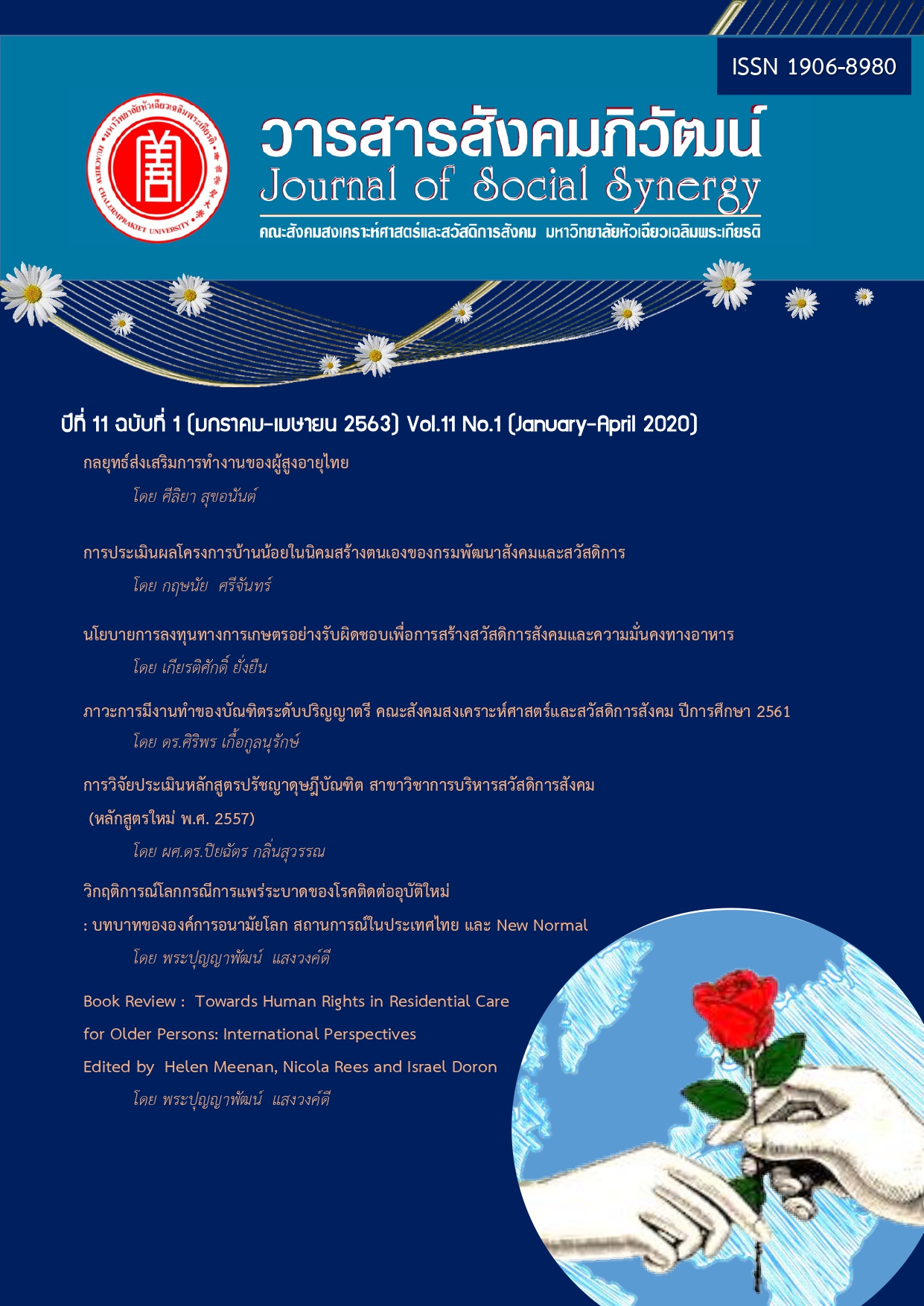The Responsible Agriculture Investment Policy to create Social Welfare and Food Security
Keywords:
Young smart farmer, Social Welfare, Food security, Responsible Agriculture Investment PolicyAbstract
The objective of this study include 1) to study and compile the policy for promoting the young farmer in Thailand during the past 8 years (A.D. 2012 - 2019) and 4 case studies of Young Smart Farmer Project; 2) to analyze the success factors and the obstacle factors in implementing the related smart farmer policy (Young Smart Farmer Project), and 3) to study the policy gaps that need to be developed or other suggestions obtained from document analysis and case studies of Young Smart Farmer and applying qualitative research included both documentary research and field research.
Keywords : Young smart farmer, Social Welfare, Food security, Responsible Agriculture
Investment Policy
The study found that the Young Smart Farmer promotion and development policy from 2012 - 2019, policy design, and operation have been continuously following the National Economic and Social Development Plan and the 20 Year National Strategy Plan also adhering to The Sustainable Development Goals (SDGs). The success factor of driving a Young Smart Farmer (YSF) requires development in many dimensions which include upstream, midstream, and downstream and also using technology, network coordination, market development, processing, and product development. Those require the knowledge of many disciplines to be involved. Therefore, it is necessary to use integrated with many departments taking part. From the analysis of the results, the study found that there are not many studies involved in YSF considered that still have to pioneer research that is a more in-depth issue or a new policy of young farmers. In an operational aspect, there are still gaps in many issues that need to be developed; such as even though there is a one-stop service policy, but in practice, it is not possible because the bureaucratic system is still step-by-step as well as putting the policy into practice has not gone to a large scale. The policy design process for the young farmer should, therefore, be open to public policy more than top-down policy. Using the participation process, it will lead to collective thinking, participation, and truly meet the target group.
References
กรมส่งเสริมการเกษตร กระทรวงเกษตรและสหกรณ์. (2560). อนาคตและทิศทางภาคเกษตรไทย เล่ม 2.
กรุงเทพฯ: ชุมนุมสหกรณ์การเกษตรแห่งประเทศไทย.
กระทรวงเกษตรและสหกรณ์. (2562.). โครงการพัฒนาเกษตรกรปราดเปรื่อง (Smart Farmer) ประจำเดือน กันยายน 2562. สืบค้นเมื่อวันที่ 10 ตุลาคม 2562 จาก https://www.moac.go.th/a4policy-alltype-401191791796
คนางค์ คันธมธุรพจน์. (2558). ความเป็นไปได้ในการจัดอาหารอินทรีย์ให้นักเรียนประถมโรงเรียนเอกชนในกรุงเทพมหานคร. วารสารการเมืองการปกครอง, 8(3): 110-131.
ภัทราภรณ์ ภัทรรังสฤษฏิ์. (2562). ผลกระทบของ DIGITAL DISRUPTION ต่อการเกษตรของประเทศไทย. วารสารครุศาสตร์อุตสาหกรรมม 18(2): 1-5.
ชลลดา ถาคำมี. (2545). อิทธิพลของอุณหภูมิสูงในระยะตั้งท้อง และผสมเกสรต่อการผสมเกสร และองค์ประกอบผลผลิตของข้าวนาปรังในภาคตะวันออกเฉียงเหนือ. (วิทยานิพนธ์ปริญญาวิทยาศาสตรมหาบัณฑิต มหาวิทยาลัยขอนแก่น, ขอนแก่น).
ประสาทพร สีกงพลี. (2560). เครือข่ายบ่มเพาะเกษตรกรรุ่นใหม่ : การเรียนรู้ร่วมกันเพื่อพัฒนารูปแบบการสร้าง
เครือข่ายเกษตรกร ภาคครัวเรือน. วารสารมหาวิทยาลัยราชภัฏมหาสารคาม, 12(1): 403-412.
ภาณี บุณยเกื้อกูล. (2560). การพัฒนาเกษตรกรรุ่นใหม่เพื่อสร้างความสามารถในการแข่งขันภาคเกษตร. รายงาน
การศึกษาส่วนบุคคลหลักสูตรนักบริหารการทูต. กรุงเทพฯ: สถาบันการต่างประเทศเทวะวงศ์วโรปการกระทรวงการต่างประเทศ.
สำนักงานคณะกรรมการพัฒนาการเศรษฐกิจและสังคมแห่งชาติ. (2554). สำคัญแผนพัฒนาเศรษฐกิจและสังคมแห่งชาติ ฉบับที่ 11 (พ.ศ.2555 – 2559). กรุงเทพฯ: สำนักงานคณะกรรมการพัฒนาเศรษฐกิจและสังคมแห่งชาติสำนักนายกรัฐมนตรี.
สำนักงานคณะกรรมการพัฒนาการเศรษฐกิจและสังคมแห่งชาติ. (2559). สำคัญแผนพัฒนาเศรษฐกิจและสังคมแห่งชาติ ฉบับที่ 12 (พ.ศ.2560 – 2564). กรุงเทพฯ: สำนักงานคณะกรรมการพัฒนาเศรษฐกิจและสังคมแห่งชาติสำนักนายกรัฐมนตรี.
สำนักวางแผนการเกษตร ทรัพยากรธรรมชาติและสิ่งแวดล้อม. (2560). เกษตรกรยุคใหม่เพื่ออนาคตประเทศไทย.
วารสารเศรษฐกิจและสังคม 54(2): 39-45.
สำนักวิชาการ สำนักงานเลขาธิการสภาผู้แทนราษฎร. (2562). การสร้างและพัฒนาเกษตรกรรุ่นใหม่. จากเอกสาร
วิชาการอิเล็กทรอนิกส์ สำนักวิชาการ สำนักงานเลขาธิการสภาผู้แทนราษฎร, สืบค้นเมื่อวันที่ 11 ตุลาคม 2562, จาก https://library.parliament.go.th/
อภิชาติ ใจอารีย์, นิรันดร์ ยิ่งยวด และนนทวัชร์ สิริพัฒนนันท์. (2559). แนวทางการพัฒนากำลังคนเพื่อเป็นผู้ประกอบการเกษตรบนเส้นทางอาชีวเกษตร: ถอดประสบการณ์โครงการสร้างและพัฒนาเกษตรกรรุ่นใหม่. วารสารการเมืองการปกครอง 6(1): 243-262.
Asian Farmers Association for Sustainable Rural Development. (2015). A Viable Future: Attracting the Youth Back to Agriculture. Retrieved November 6, 2019 from http://asianfarmers.org/wp-content/uploads/2014/12/Attracting-Youth-in-Agriculture-in-Asia_Scoping-Rev-08242015.docx
Faysse, N., Aguilhon, L, Phiboon, K., Purotaganon, M. (2560). Relations between farm characteristics, agricultural production and water resources in Prachinburi Province, Thailand (ความสัมพันธ์ระหว่างคุณลักษณะของเกษตรกร, ผลผลิตทางการเกษตร และทรัพยากรน้าในจังหวัดปราจีนบุรี ประเทศไทย): Shaping the present, influencing opportunities for evolution (การจัดการสถานการณ์ปัจจุบันและการหาแนวทางสาหรับการพัฒนา). Unpublished paper.
Khunpisuth. (2010). วิกฤติแรงงานภาคเกษตร. (online). Retrieved November 6, 2019 from
http://mangobar.wordpress.com/2010/12/18.
Nilsen, J. (2557). Remittances and development: the impact of remittances on livelihood security (การส่งเงินค่าเลี้ยงดูกับการพัฒนา: ผลกระทบจากการส่งเงินค่าเลี้ยงดูต่อความเป็นอยู่ของคนในชุมชน). Evidence from Ko Kaeo sub-district, Thailand. Master thesis, University of Agder, Kristiansand, Norway.
Whitebrook, A. (2016). Agricultural Productivity and the Luck of Young Farmers. Retrieved November 6, 2019 from http://www.futuredirections.org.au/publication/agricultural-productivity-lack-young-farmers/
Downloads
Published
How to Cite
Issue
Section
License
บทความที่ได้รับการตีพิมพ์เป็นลิขสิทธิ์ของวารสารสังคมภิวัฒน์ มหาวิทยาลัยหัวเฉียวเฉลิมพระเกียรติ
ข้อความที่ปรากฏในบทความแต่ละเรื่องในวารสารวิชาการเล่มนี้เป็นความคิดเห็นส่วนตัวของผู้เขียนแต่ละท่านไม่เกี่ยวข้องกับมหาวิทยาลัยหัวเฉียวเฉลิมพระเกียรติ และคณาจารย์ท่านอื่นๆในมหาวิทยาลัยฯ แต่อย่างใด ความรับผิดชอบองค์ประกอบทั้งหมดของบทความแต่ละเรื่องเป็นของผู้เขียนแต่ละท่าน หากมีความผิดพลาดใดๆ ผู้เขียนแต่ละท่านจะรับผิดชอบบทความของตนเองแต่ผู้เดียว




